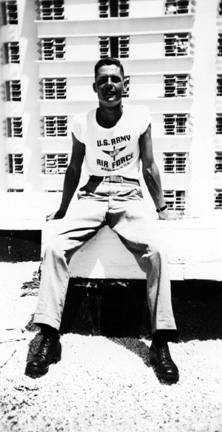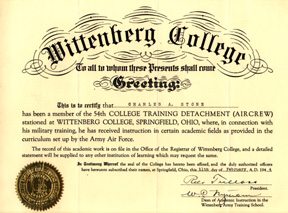Biographical Notes reCharles A. (Chuck) StonePage 1 of 3 Pages, of Chapter 2,INTRODUCTION TO MILITARY AVIATION |
|||||||||||
| When I reported for induction at the Federal Building in Minneapolis, I found myself in the company of a fellow prospective Aviation Cadet by the name of Bill Wagner. Bill was from the town of Akeley, Minnesota, located just about eighteen miles east of Park Rapids. Bill and I had ample time to compare notes and become fast friends on the extended train trip to Miami Beach. We ended up rooming together in the Lord Baltimore Hotel, just across from the Sea Isle Hotel, which was located right on the beach. We were quickly transformed into uniformed troops, learning to march to and from every scheduled activity, singing standard marching songs along the way. We took classroom instruction outdoors in our fatigues, in groups, on an old golf course. When time came to do our session of physical training, we would strip our fatigues off and exercise in our boxer shorts. As things developed, when doing side-straddle-hop exercises, things got a bit out of hand. After hearing complaints from women walking by on the street, our supervisors ordered us to pin the fly on our shorts closed to keep body parts from flapping about in the broad daylight. |
|||||||||||
 |
|||||||||||
|
August, 1943 |
|||||||||||
|
It was quite an experience to complete our exercise program, where we had rolled around in the dirt and sand extensively, then put our fatigues back on and march off to our next class or back to the chow hall or the barracks (Hotel?). We would all need a good hot shower, but it was not available. We all took tub baths in cold water. All hot water had been turned off at the source. We drilled in the sand by the ocean, which became another form of physical training.
As has been noted by other story contributors with similar experiences, the enlisted drill sergeants who governed our every breath and movement during this training period, were often functionally illiterate when it came to reading or writing the printed word. They had the “Hup Ho” stuff down pat, but when they got a letter from their mother or girl friend, one of us had to sit down with them and read it for them. They gave us humane treatment and fulfilled their duty assignments in an appropriate manner, so we gave them our respect in return and learned a bit about military life and processes. As I recall, we were in basic training at Miami Beach about six weeks. When the program had been completed, Bill and I were assigned to CTD (College Training Detachment) at Wittenberg College, Springfield, Ohio. |
|||||||||||
| Our group’s assignment there was scheduled to last for up to five or six months. We learned that earlier classes had often been shipped to Classification Centers in as little as four months. As it ended up, ours was the first class to complete the full six months training period. In retrospect, I can see that the CTD programs fulfilled a number of purposes. While there, Cadets were 1) taught and/or were refreshed on a variety of academic subjects of interest in fields of expected performance; 2) We were taught military procedures and discipline. 3) the CTDs, provided a flexible holding pool to funnel Cadet candidates into the Classification Centers — pilot, navigator, bombardier — as training spaces and equipment were available; 4) We were given a ten hour introduction to flying training in Piper Cubs |
|||||||||||
 |
|||||||||||
| One of my memories of this experience is that the singer, Gordon MacRae, was one of the cadets at Wittenberg College. He was our Cadet Adjutant. Massed formations were the rule at Wittenberg. Every workday evening we would form up out on the athletic field. I can remember Gordon giving the marching orders with a voice that could be heard throughout the campus and off we would march in review, colors flying. Occasionally, during a massed gathering he would be asked by our supervisors to sing a song. I can recall hearing him sing “That Old Black Magic,” a cappella, in an unforgettable manner. |
|||||||||||
| Towards the end of our training period, I ended up in a nearby military hospital with some kind of a bug. Under their treatment, I became increasingly ill until the day a doctor said “Maybe he is allergic to the sulfa drug we are using to cure his illness.” They stopped treating me and I got well quickly and was able to ship out to Classification at Lackland Air Base, San Antonio, Texas, on schedule. My buddy, Bill Wagner, was not so lucky. He had a vicious ear infection and was held over to the next class. |
|||||||||||
 |
|||||||||||
| As it worked out for him, the delay was such that he ended up in a class that was being trimmed down due to fewer aircrew combat loses than had been anticipated. Bill ended up in Radio School and I was to encounter him later on at Clovis Air Base, New Mexico. |
|||||||||||
| By mid-February, 1944, we were on our way to the San Antonio Aviation Cadet Classification Center. The classification process (S.A.A.C.C.) went according to plan. Lots of physical, psychological and other kinds of tests. There was considerable time spent out on the obstacle course and getting in our quota of PT. We were allowed to sign up for our preference as pilot, navigator or bombardier. What I remember most is the waves of rumors that would sweep through the barracks. One day they would say that if you didn't volunteer to be a bombardier you would be shipped off for gunnery school. The rumor information changed daily with the wind and weather. I stuck to my guns and asked for pilot training — and got it! Off to Pine Bluff, Arkansas, for Primary Flight Training in the Fairchild PT-19. |
|||||||||||
 |
|||||||||||
|
|
|||||||||||
| We traveled by a train where each car was furnished entirely with bunk beds, bolted to the floor. You got on the train, went to bed, got up to piddle or eat, and waited to arrive at your destination in a horizontal position. I have no complaint about this. It was the spring of 1944 and the trip was quite comfortable. Facilities at the Pine Bluff school were about as close to a resort atmosphere as I could hope for as a military cadet. We were there to see if we were adaptable to flying airplanes and they wasted little time getting carried away with military discipline and procedures. We had civilian contract pilots and military check pilots. Compared to the check pilots that Earl Myers experienced in his training, ours were very down to earth human beings. Each instructor had four or five students. My instructor was a very mellow, well-formed but a bit stocky, handsome fellow. He was really relaxed when he met us on the flight line. Some might say he was hung over. I get the impression that he had been striving to make time with every available female in that part of Arkansas and had maybe only two or three yet to add to his score card. He was really bushed. But, he was a good instructor and he brought out the best in his students. We all soloed on schedule and I don’t recall anyone in his group washing out. I really enjoyed flying the PT-19 and was looking forward to stepping up to the Basic Trainers. |
|||||||||||
|
End of Page 1 of 3 of Pages, Chapter 2 — Go to Page 2 Click below to select a destination Go to Page 1 — 2 — 3, this Chapter Chapters 1 — 2 — 3 — 4 — 5 — 6 — 7 — 8 — 9 — 10 |
|||||||||||